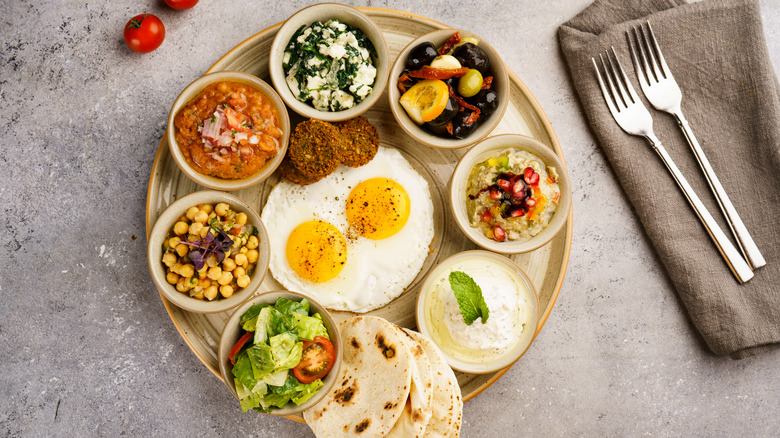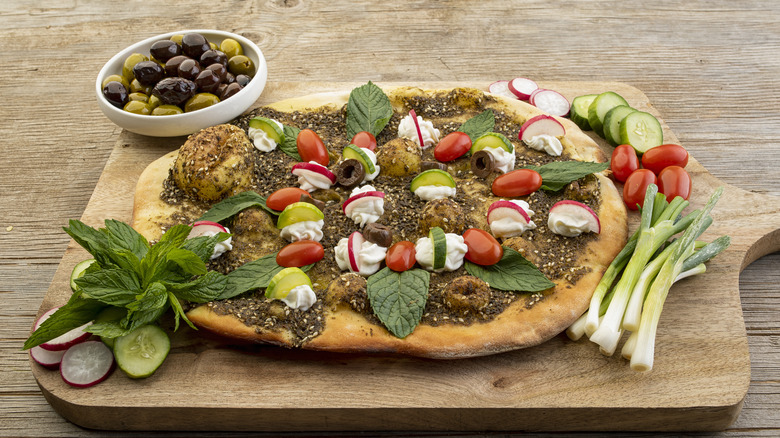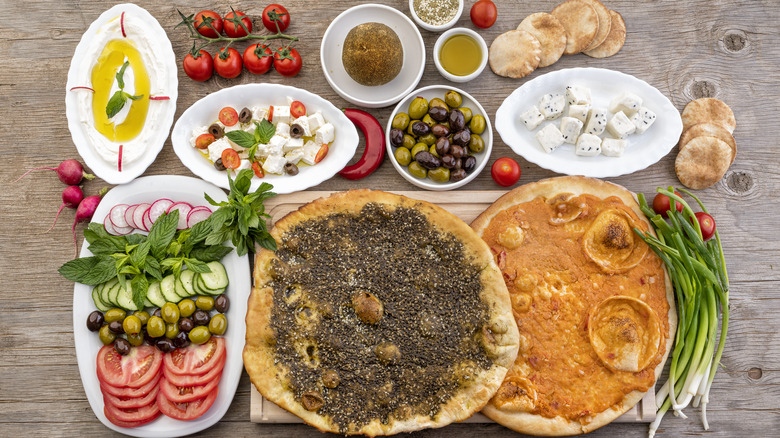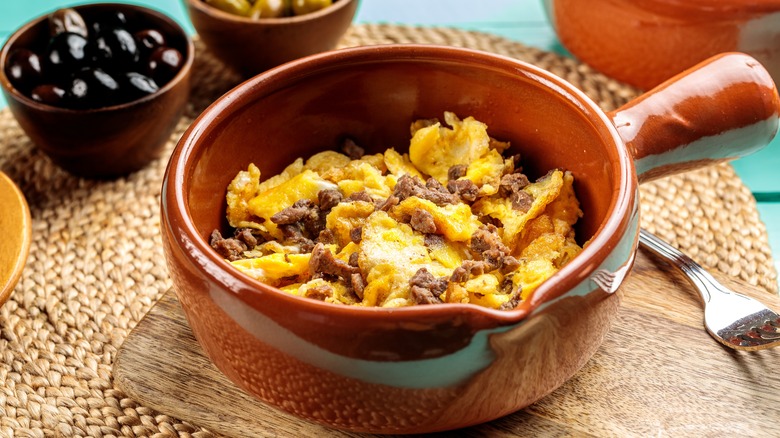Why Breakfast In Lebanon Is Actually The Most Important Meal Of The Day
If you're a breakfast person who loves having family and friends sitting around the table in the morning, you'll love waking up to a Lebanese breakfast. Food is central to the social fabric in this Middle Eastern country, and it is reflected in a popular Arabic saying that, when translated, means "If you eat alone, you die alone." The first meal of the day is an occasion for Lebanese families to gather together, with an assortment of small plates featuring various dishes served for everyone to share. This style of dining is called mezze, and it is popular in the Middle Eastern and Mediterranean cultures as well as in the North African, Balkan, and West Asian regions.
Family traditions are the bedrock of Lebanon's food culture, with kitchen rituals and recipes for classic dishes passed down through generations. When it comes to breakfast, effort is taken to prepare a variety of food first thing in the morning so the meal becomes a leisurely communal activity. It's an opportunity as well to dissolve tension between family members since in Lebanese culture, food is commonly used as an agent for bringing people together, especially to resolve conflict.
Breakfast is also a vehicle for using locally sourced ingredients to prepare hearty dishes. Traditional Lebanese cuisine is recognized for its use of minimally processed produce, but with younger generations adopting a more Westernized diet, a classic homemade breakfast offers an opportunity to connect to their roots and eat more healthily.
Their breakfast pastry is recognized as a cultural icon
A Lebanese breakfast staple has been added to UNESCO's list of products that represent the intangible cultural heritage of humanity. Manousheh, also referred to as al-man'ouché and manakish, is a white flatbread that's widely eaten in Lebanon. Before getting baked in the oven, the dough is topped with za'atar, salt, and olive oil, with the hand-made indentations on the dough serving as shallow pockets for containing the spices. Once it's cooked, it's further topped with tomato and cucumber slices, olives, mint leaves, and labneh. A fermented milk product rich in proteins, nutrients, and probiotics, labneh is a superfood people should eat more of.
The UNESCO distinction recognizes manousheh's cultural significance as a breakfast item enjoyed by Lebanese citizens of all economic backgrounds. It also serves as a central dish for morning gatherings. It's often referred to as Lebanese pizza, although manousheh predates the Italian dish. While pizza dates back to the late 18th century, flatbread recipes that use thyme and olive oil were already mentioned in the 10th-century Arabic cookbook "Kitab al-Tabikh."
Aside from being healthy, manousheh smells and tastes wonderful due to the Lebanese cuisine's penchant for using aromatic herbs and spices. The aforementioned za'atar, for example, is a richly flavored and complex seasoning that mixes the nutty sweetness of sesame seeds with tangy sumac, earthy and woodsy oregano and marjoram, and minty thyme. Za'atar can be made at home as a seasoning for everything, from bread to savory dishes.
Traditional Lebanese breakfast dishes use healthy and flavorful ingredients
Located along the eastern Mediterranean shore, Lebanon has been exposed to different culinary influences, from the Middle East and North Africa to Europe. These show up in the other staples you'll find on a Lebanese breakfast table.
One is ful medames. Originating from Egypt, it's a dish made of cooked fava beans seasoned with lemon juice, crushed garlic, and cumin. Served with a side of fresh tomatoes, sliced onions, pickles, parsley, and mint, it is eaten by scooping up the beans with pieces of warm pita bread.
Another import, this time from Syria, is the creamy hummus, which is incorporated into different breakfast items. An example is fatteh, a layered dish with a base of crisped-up pita chips and a topping of toasted pine nuts. Tasty and filling, fatteh is very economical since leftover pita bread can be used to make it. Musabbaha is another hummus-based breakfast favorite. Featuring a thick and creamy consistency, it has cooked chickpeas soaked in a sauce of lemon juice and tahini seasoned with salt, cumin, and garlic. Musabbaha is topped with olive oil, paprika, and parsley and often served with a side salad.
All these classic breakfast dishes are emblematic of Lebanese cuisine's use of healthy and flavorful ingredients: fresh vegetables, whole grains, olive oil, yogurt, and fragrant herbs and spices. As for drinks, the Lebanese like their coffee bold and intense, with a bit of sugar and cardamom added in.
The other savory and sweet flavors of a Lebanese breakfast
While most of the country's traditional breakfast dishes are generally vegetable-based, Lebanon also has its version of bacon and eggs. Awarma or kawarma is a lamb confit that used to be a way for the Lebanese to preserve meat when refrigeration technology wasn't developed yet. It's prepared by mincing and curing lamb meat and then cooking it in rendered lamb fat. The preserved meat is often fried in a skillet with either scrambled or sunny-side-up eggs for breakfast, although it's also added to stews and pilaf as seasoning.
Another beloved breakfast item is the fatayer, a pastry that can be eaten as an appetizer, a snack, or a light meal. Filled with spinach and onions and flavored with sumac, fatayer is typically vegetarian, but minced meat can be added to the filling to make it more savory.
Those who have a sweet tooth will enjoy the knafeh. One of the traditional dishes enjoyed during Ramadan, knafeh is eaten both during breakfast and as a dessert. This baked pastry has cheese layered with shredded phyllo dough and is topped with chopped pistachios and a drizzling of sugary syrup. The cheese used is something soft like ricotta or the chewy and slightly salty ackawi. Lusciously buttery and crunchy, knafeh can be eaten on its own or with kaak, a purse-shaped bread roll topped with sesame seeds.



